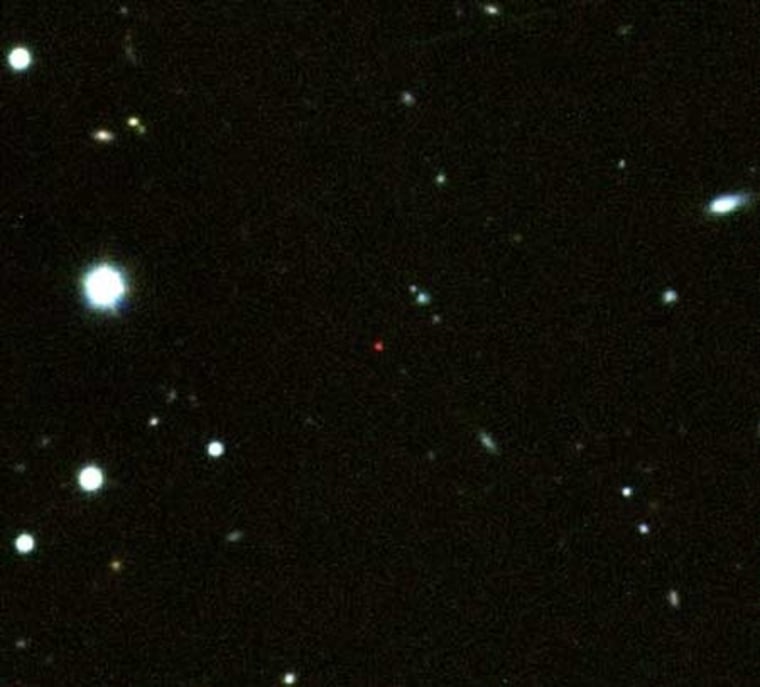Light from a star that exploded 13 billion years ago has been detected, becoming the most distant object in the universe ever observed.
The light from the distant explosion, called a gamma-ray burst, first reached Earth on April 23 and was detected by NASA's Swift satellite. Gamma-ray bursts are thought to be associated with the formation of star-sized black holes as massive stars collapse.
Within hours, telescopes around the world were turned on the burst — the most violent explosions in the universe — observing its fading afterglow to glean clues about its source and location.
Two teams, one using the European Southern Observatory's 8.2-meter Very Large Telescope, located in La Silla, Chile, and the other using the 3.6-meter Italian Telescopio Nazionale Galileo in Spain, pinpointed the distance to the blast, dubbed GRB 090423, at more than 13 billion light-years from Earth. (The previous record holder, GRB 080913, was 12.8 billion light-years distant.)
This enormous distance means that the gamma-ray burst occurred just 630 million years after the theoretical Big Bang, when the universe was only four percent of its current age.
'Spine-tingling' discovery
In recent years, astronomers have been detecting gamma-ray bursts, galaxies and quasars at ever farther distances, closer to the birth of the universe's first stars and galaxies. So it was only a matter of time before they detected such an early explosion, said Nial Tanvir of the University of Leicester in the U.K. Tanvir worked on the ESO team.
"We have been looking for a burst like this for several years, so we of course expected that we'd get lucky one day — but it was a "spine-tingling" moment to realize that this was finally it," Tanvir told SPACE.com.
Astronomers hope that observations of this and other gamma-ray bursts just as far away (and thought to represent some of the earliest stellar populations) will shed light on the so-called "cosmic dark ages," a time before the first stars and galaxies ignited.
Slideshow 12 photos
Month in Space: January 2014
"This explosion provides an unprecedented look at an era when the universe was very young and also was undergoing drastic changes," said Dale Frail of the National Radio Astronomy Observatory. "The primal cosmic darkness was being pierced by the light of the first stars and the first galaxies were beginning to form. The star that exploded in this event was a member of one of these earliest generations of stars."
Cosmic dark ages
After the Big Bang, the universe had cool rapidly as it expanded. About 400,000 years later, free electrons and protons (negative and positive charges, respectively) combined to form neutral atoms, leaving the universe awash in a background radiation that we currently can detect in the microwave part of the electromagnetic spectrum (the so-called Cosmic Microwave Background).
The universe stayed in this neutral stage until the first stars and galaxies light it up. The photons from these stars knocked electrons free from the atoms, "re-ionizing" the universe. But detecting the most distant galaxies and quasars from this period is difficult, and so astronomers are hoping that distant gamma-ray bursts such as GRB 090423 will give them information about this re-ionization period.
It will likely take many more gamma-ray bursts to say anything definitive about this cosmic dark age though.
At present, we have only a few observations from these early epochs. Thus, even a single, new data may provide useful constrain to our models of the early Universe. However, to be frank, a decisive step forward for our knowledge of this period of the Universe's history requires the collection of a relatively large sample of distant [gamma-ray bursts]," Ruben Salvaterra of the National Institute of Astrophysics in Italy told SPACE.com. Salvaterra worked on the Italian Telescopio Nazionale Galileo team.
Both team's observations are detailed in the Oct. 29 issue of the journal Nature.
Asked how long he thought this distance record would hold, Tanvir replied, "Based on past experience, it could certainly be a few years before it's broken, but it wouldn't entirely surprise me if it was tomorrow." He said he did expect the next record holder to be another gamma-ray burst.

